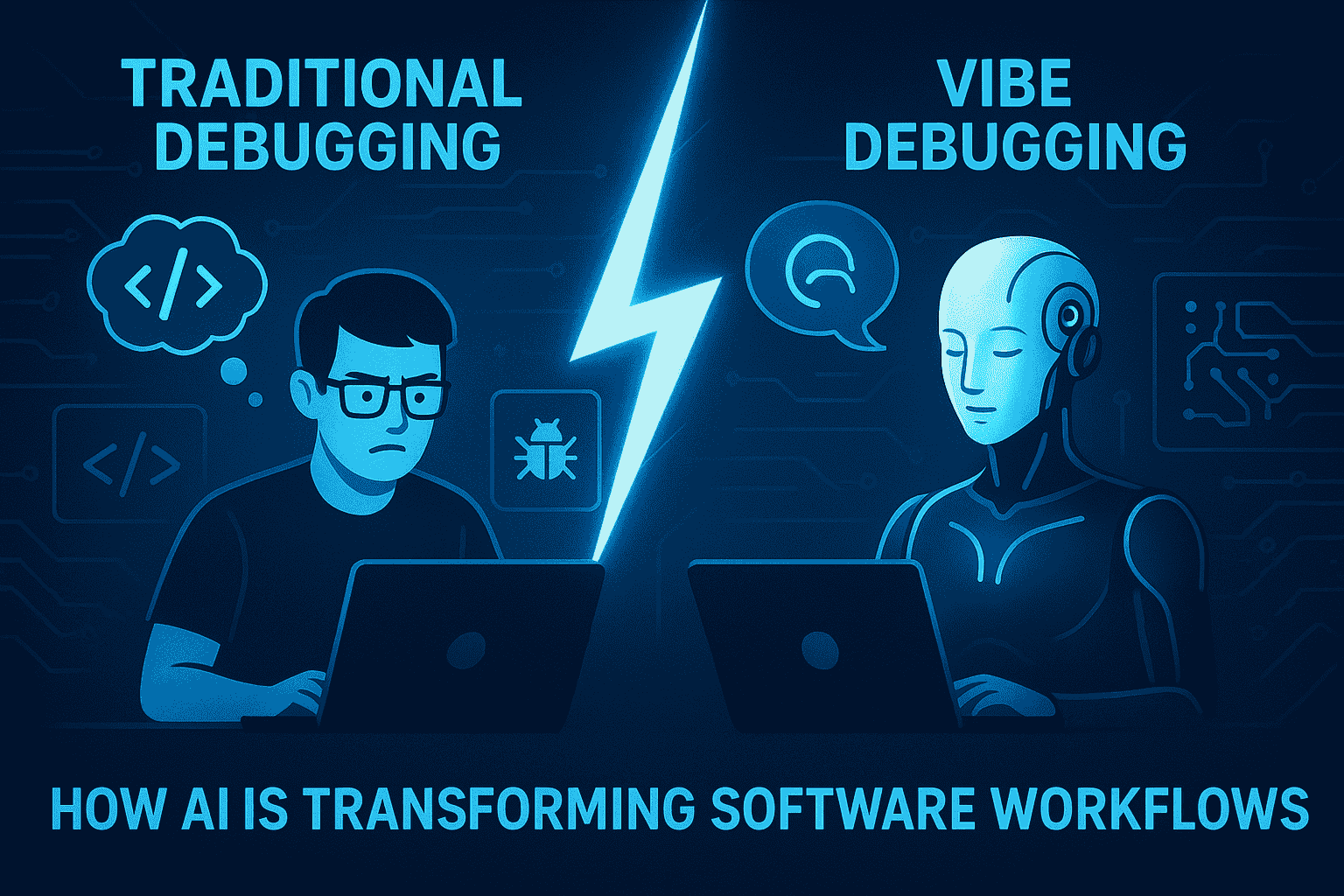Debugging has always been a paradox in software development. It’s both essential and exhausting. Every engineer knows the feeling of chasing an elusive bug through log files and stack traces at the end of a sprint.
Despite advances in testing and automation, debugging remains one of the most time-consuming tasks in modern engineering. As teams scale and release cycles shorten, the old way of debugging—manual, reactive, and fragmented—no longer fits.
That’s where vibe debugging enters the conversation: a new approach that’s less about finding errors and more about understanding how the system feels before things go wrong.
Traditional Debugging: Nature and Struggles
Traditional debugging is fundamentally reactive. A problem surfaces—a test fails, a build breaks, or a user reports a bug—and developers scramble to identify what went wrong. They use print statements, breakpoints, and manual inspection to isolate the issue. The goal is to reproduce, diagnose, and fix.
It works, but it’s tedious. Each debugging cycle involves context switching between tools, rerunning code repeatedly, and mentally reconstructing state. In a modern CI/CD environment, this often becomes a bottleneck. It’s not unusual for developers to spend 25–50% of their time debugging, much of it in repetitive investigation.
Traditional debugging was designed for a simpler era: when releases were infrequent, and systems were monolithic. But today’s distributed, service-oriented architectures introduce complexity at every layer. What used to be a single stack trace now spans multiple services, environments, and pipelines.
Why Traditional Debugging Struggles in Modern Teams
In high-velocity engineering teams, manual debugging introduces friction.
Every bug fix delays a release, increases merge pressure, and amplifies cognitive load.
Developers lose their understanding of context-aware code reviews—they jump between code, tests, logs, and dashboards.
This fragmentation hurts both speed and quality. By the time a bug is identified, valuable time has been lost. It also leads to review fatigue: engineers approving pull requests without adequate inspection simply to keep pipelines unblocked.
Traditional debugging doesn’t scale well across distributed teams or fast CI/CD pipelines. As organizations adopt microservices, asynchronous APIs, and rapid iteration cycles, debugging becomes a full-time job instead of a step in the process.
The Emergence of Vibe Debugging
Vibe debugging is a paradigm shift in how developers interact with code problems.
It represents a move from reaction to anticipation, from isolated inspection to contextual awareness. Rather than waiting for a bug to manifest, vibe debugging uses intelligence—often powered by AI—to interpret the system’s vibe: the signals, anomalies, and inconsistencies that suggest something is off before it fails.
This approach combines insights from AI code review tools, continuous testing frameworks, and conversational AI. Instead of relying on after-the-fact investigation, it builds a continuous feedback loop between code changes and their downstream effects.
Developers receive real-time insights, not just error messages.
So, What is the “Vibe”?
In practical terms, a codebase’s “vibe” is its behavioral fingerprint. It’s how the system reacts to change—the small deviations in patterns, performance, or logic that hint at instability. Vibe debugging tools learn these patterns over time.
When something changes—a new function, dependency, or configuration—the system doesn’t just test functionality; it evaluates how the change feels compared to the baseline. For example, an AI-driven reviewer might flag that a new module increases latency in a critical API, even if all tests pass. It understands the context behind the code, not just its syntax.
This is where traditional debugging stops and vibe debugging begins.
How Vibe Debugging Works in Practice
A modern vibe debugging system integrates several intelligent layers:
- AI Code Review:
Code changes are automatically scanned for potential issues using machine learning models trained on previous commits, bug reports, and best practices.
This step identifies logical inconsistencies and security risks before human review begins. - Behavioral Monitoring:
Continuous integration pipelines track not only whether code runs but how it behaves.
Anomalies in performance metrics, test execution patterns, or dependency interactions trigger early alerts. - Conversational Insight:
Developers chat with debugging assistants through natural language.
Instead of searching logs, they can ask, “What changed in this function?” or “Why did the response time spike?”
The AI provides contextual answers supported by data. - Self-Improving Feedback Loop:
Each debugging session contributes new insights.
Over time, the system learns what kinds of issues commonly occur in a given repository or service and proactively highlights them.
The result is a debugging process that feels less like firefighting and more like continuous understanding.
Traditional Debugging vs. Vibe Debugging
| Aspect | Traditional Debugging | Vibe Debugging |
|---|---|---|
| Approach | Reactive, triggered by failure | Proactive, driven by context |
| Tools | Breakpoints, logs, consoles | AI review agents, behavioral analysis |
| Scope | Single system or function | Cross-system, holistic |
| Speed | Time-consuming and linear | Parallel and real-time |
| Feedback | After error occurs | Before error occurs |
| Focus | Fixing symptoms | Understanding root causes |
This comparison underscores a broader truth: vibe debugging aligns with how modern engineering already operates—distributed, data-driven, and automated.
The Role of AI in Modern Debugging
Artificial intelligence has already transformed software creation through predictive typing, code completion and summary, and intelligent testing. The natural next step is applying AI to debugging itself.
By analyzing past incidents, historical code patterns, and performance data, AI can recognize problems that humans might overlook.
An AI-driven assistant doesn’t replace the engineer.
It amplifies them.
It provides instant hypotheses, simulates test conditions, and visualizes causal relationships between modules. The developer’s role shifts from detective to decision-maker.
This shift mirrors the broader evolution of software development toward AI-augmented engineering—where tools act as collaborators rather than utilities.
Why Vibe Debugging Matters Now
The timing for this change is not accidental. Engineering teams are under unprecedented pressure to deliver faster while maintaining quality and reliability. With releases happening daily or hourly, traditional debugging cannot keep up.
At the same time, developers are increasingly comfortable with AI in their workflows. From GitHub Copilot to automated code quality tools, AI assistance has become an expected part of the stack. Vibe debugging extends this trust from creation to correction, ensuring that errors are understood in context rather than discovered by surprise.
In this environment, debugging must evolve from a reactive step to an embedded capability—one that lives inside the development cycle, not outside of it.
Benefits of Adopting Vibe Debugging
The adoption of vibe debugging practices provides measurable gains across engineering teams:
- Faster Issue Resolution:
By catching inconsistencies early, teams reduce the time between detection and fix. - Reduced Review Fatigue:
AI handles repetitive checks, allowing human reviewers to focus on logic and design. - Improved Code Quality:
Continuous behavioral monitoring ensures changes align with expected performance baselines. - Enhanced Collaboration:
Conversational interfaces democratize debugging—any team member can query and understand system behavior without deep infrastructure knowledge. - Higher Developer Satisfaction:
Less firefighting and more problem-solving lead to better morale and productivity.
These benefits compound over time, transforming debugging from a cost center into a strategic advantage.
Integrating Vibe Debugging into Existing Workflows
The best part of this emerging paradigm is that it doesn’t require a total process overhaul. Most vibe debugging systems integrate directly into familiar environments—IDEs, GitHub, GitLab, or cloud CI pipelines.
As pull requests open, automated analysis begins. When anomalies are found, developers are notified directly within their existing tools. This keeps workflows seamless while providing a richer layer of context than traditional logging systems.
Over time, these insights build an institutional memory of the codebase—what patterns have failed before, which dependencies cause risk, and where the system tends to degrade. That knowledge becomes an asset shared by both humans and AI.
Industry Momentum Toward Proactive Debugging
Across the industry, there is growing recognition that debugging must evolve. Cloud-native applications, container orchestration, and AI-driven development all introduce complexity that manual debugging cannot manage efficiently.
Leading tools in the ecosystem are already embedding AI-driven diagnostics into their pipelines. From open-source projects experimenting with predictive testing to enterprise-grade observability platforms, the shift toward proactive debugging is well underway. Vibe debugging represents the next logical layer of that evolution—one that unifies data, analysis, and collaboration into a single, intelligent process.
The Road Ahead
As this paradigm matures, debugging will become increasingly autonomous. Systems will not only detect their own faults but will also propose and validate corrections. Developers will transition from debugging individual failures to designing systems that understand their own state.
This is not a vision of replacement but of augmentation. By embedding intelligence directly into the debugging loop, teams will achieve unprecedented velocity and reliability.
How Panto Is Advancing Vibe Debugging
Panto AI is among the companies shaping this transformation.
Its team is building the world’s first end-to-end vibe debugging platform, designed to connect AI-driven code review, behavioral analysis, and conversational feedback in a single workflow.
The platform aims to turn debugging into a continuous dialogue—where developers and AI agents collaborate to identify, explain, and resolve issues without breaking flow. By merging automation with understanding, it represents a tangible step toward debugging that thinks alongside developers.
Conclusion
Traditional debugging will always have its place. It’s the foundation of how developers learn to reason about systems. But as software scales and complexity deepens, the tools must evolve. Vibe debugging offers a path forward: contextual, conversational, and continuously adaptive.
The shift from traditional debugging to vibe debugging isn’t merely technical. It’s cultural. And as teams adopt this mindset, the way we experience and improve code will never be the same.






